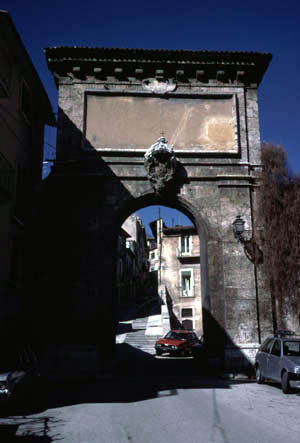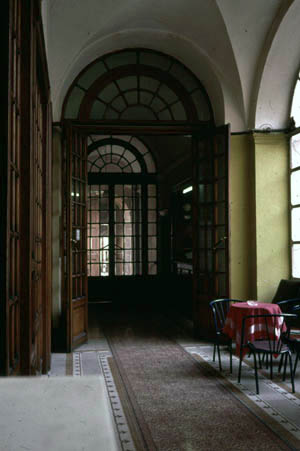 |
Manhattan's Theater for the New City (TNC) joined with La Piccola Brigata of L'Aquila for a theater exchange in the 1988-1989 theater season. The Italian company brought a realistic play by a local author to TNC and Crystal Field, Artistic Director of TNC, wrote and directed a play that she thought would tour well in Italy. It was a vaudeville musical, "One Director Against His Cast," filled 1920s songs, Smith-and-Dale routines and physical comedy. We flew to Rome via Alitalia and rode by chartered bus to the ancient walled city of L'Aquila, capital city of Abruzzi, where we spent about two weeks as guests of the Italian company and the citizens of the town.
Some of us slept as guests in the homes of members of the Italian troupe, but most of us were lodged in the Grande Albergo (Grand Hotel) in the center of the city. It was a very old hotel, with plain rooms and no private baths, but it was the best we could afford. There was a telephone in the lobby. The hotel's atmosphere was like a prewar scene from Lina Wertmuller's "Seven Beauties" or any number of Fellini films, and memories of Italian films flashed though my mind throughout my stay.
I couldn't carry much camera equipment since we traveled light on personal possessions. (We packed our props, sets and costumes in our luggage.) I brought only one camera--my Leica CL with a 40mm f2.0 normal lens and a 90mm f2.8 mild telephoto. But I knew from experience that my color correcting kit would be needed in such high elevations as this mountain city. I used a color meter and color correcting diopter filters, including ultraviolet filters, in most of my daytime shots. Despite these precautions, the high elevation of the city tended to make many photographs blue. Other photos turned out violet because of the prevalence of ultraviolet light on cloudy days. Over the years, color shift in the slides has become another problem. My slides were carefully stored, but time has caused some changes in them. In scanning them, I have tried to restore them to the colors I remember. (I'm a perfectionist when it comes to color.) But I have been largely unsuccessful in replicating the delicate yellow of many walls and the neutral grey of many old stone structures that live on in my mind's eye. Most of these pictures were taken with Kodachrome 200 film. My Agfachrome 100 slides were slightly better at capturing the yellow tones of Italy, but this and other E-6 films are not archival. My E-6 slides have not retained their colors too well over the years. I shot no print film. The only black and white I shot was the publicity picture you see above.
|




